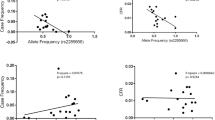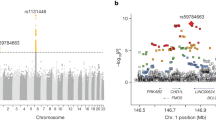Abstract
The CCR5-Δ32 genotype is known to influence HIV-1 transmission and disease. We genotyped 1301 US women of various races/ethnicities participating in the HIV Epidemiologic Research Study. None was homozygous for CCR5-Δ32. The distribution of heterozygotes was similar in HIV-1 infected and uninfected women. Thirty-seven (11.8%) white, 28 (3.7%) blacks/African Americans (AA), seven (3.3%) Hispanics/Latinas, and one (6.6%) other race/ethnicity were heterozygous. The frequency of heterozygotes differed among sites for all races combined (P = 0.001). More heterozygotes were found in AA women in Rhode Island (8.9%) than in the other sites (3.1%) (P = 0.02), while heterozygosity in white women was most common in Maryland (28.6%) (P = 0.025). These regional differences could be accounted for by racial admixture in AAs, but not in whites. Regional variations should be considered when studying host genetic factors and HIV-1 in US populations.
This is a preview of subscription content, access via your institution
Access options
Subscribe to this journal
Receive 6 digital issues and online access to articles
$119.00 per year
only $19.83 per issue
Buy this article
- Purchase on Springer Link
- Instant access to full article PDF
Prices may be subject to local taxes which are calculated during checkout
Similar content being viewed by others
References
Samson M, Libert F, Doranz BJ et al. Resistance to HIV-1infection in Caucasian individuals bearing mutant alleles of the CCR-5 chemokine receptor gene Nature 1996 382: 722–725
Liu R, Paxton WA, Choe S et al. Homozygous defect in HIV-1 co-receptor accounts for resistance of some multiply-exposed individuals to HIV-1 infection Cell 1996 86: 367–377
Dean M, Carrington M, Winkler C et al. Genetic restriction of HIV-1 infection and progression to AIDS by a deletion of the CKR5 structural gene Science 1996 273: 1856–1862
Huang Y, Paxton WA, Wolinsky SM et al. The role of a mutant CCR5 allele in HIV-1 transmission and disease progression Nat Med 1996 2: 1240–1243
Michael NL, Chang G, Louie LG et al. The role of viral phenotype and CCR-5 gene defects in HIV-1 transmission and disease progression Nat Med 1997 3: 338–340
Eugen-Olsen J, Iversen AK, Garred P et al. Heterozygosity for a deletion in the CKR-5 gene leads to prolonged AIDS-free survival and slower CD4 T-cell decline in a cohort of HIV-seropositive individuals AIDS 1997 11: 305–310
Smith DK, Warren DL, Vlahov D et al. Design and baseline participant characteristics of the human immunoldeficiency virus (HER) study: a prospective cohort study of human immunodeficiency virus infection in US women Am J Epidemiol 1997 146: 459–469
Solomon L, Styein M, Flynn C et al. Health services use by urban women with or at risk for HIV-1 infection: the HIV Epidemiology Research Study (HERS) J Acquir Immune Defic Syndr Hum Retrovirol 1998 17: 253–261
Guo SW, Thompson EA . Performing the exact test of Hardy-Weinberg proportion for multiple alleles Biometrics 1992 48: 361–372
Zimmerman PA, Bucklerwhite A, Alkhatib G et al. Inherited resistance to HIV-1 conferred by an inactivating mutation in CC chemokine receptor 5 – studies in populations with contrasting clinical phenotypes, defined racial background, and quantified risk Mol Med 1997 3: 23–36
O’Brien TR, Padian NS, Hodge T et al. CCR5 genotype and sexual transmission of HIV-1 AIDS 1998 12: 444–445
Burger H, Tarwater P, Kleeberger C et al. CCR5 genotype and susceptibility to transmission of HIV-1 to women. Abstract No.WePeA3998 XIIIth International AIDS Conference, Durban, South Africa, 9^14 July 2000
Williams RC, Steinberg AG, Knowler WC, Pettitt DJ . Gm 3; 5, 13, 14 and stated-admixture: independent estimates of admixture in American Indians Am J Hum Genet 1986 39: 409–413
Kokkotou E, Philippon V, Gueye-Ndiaye A et al. Role of the CCR532 allele in resistance to HIV-1 infection in West Africa J Hum Virol 1998 1: 469–474
Elharti E, Elaouad R, Simons M et al. Frequency of the CCR5 Δ32 allele in the Moroccan population AIDS Res Hum Retrov 2000 16: 87–89
Martinson JJ, Chapman NH, Rees DC, Liu YT, Clegg JB . Global distribution of the CCR5 gene 32-basepair deletion Nat Gen 1997 16: 100–103
Lu C, Williams T, Makuwa M et al. Analysis of genetic polymorphism of the HIV-coreceptor (CCR5) locus in a Gabonese population (abstract 044A297). Presented at Xth International Conference on AIDS and STD in Africa, Abidjan, December 1997
Stephens JC, Reich DE, Goldstein DB et al. Dating the origin of the CCR5-Delta 32 AIDS-resistance allele by the coalescence of haplotypes Am J Hum Genet 1998 62: 1507–1515
Lucotte G, Mercier G . Distribution of the CCR5 gene 32-bp deletion in Europe J Acquir Immune Defic Syndr Hum Retrovirol 1998 19: 174–177
Acton RT, Harman L, Go RCP, Tseng ML, Bias W . Comparison of HLA phenotypes among African Americans from Alabama, Maryland, and North Carolina Transplant Proc 1993 25: 2404–2407
Terasaki PI, Gjertson DW (eds). HLA 1997 UCLA Tissue Typing Laboratory: Los Angeles 1997 pp 317–323
Gjertson DW, Terasaki PI (eds). HLA 1998 American Society of Histocompatibility and Immunogenetics: Lenexa 1998 pp 231–234
Terasaki PI, Gjertson DW (eds). HLA 1997 UCLA Tissue Typing Laboratory: Los Angeles 1997 pp 336–346
National Center for HIV, STD and TB prevention. Divisions of HIV/AIDS Prevention. HIV/AIDS among US Women: minority and young women at continuing risk Centers for Disease Control and Prevention. Atlanta, GA http://www.cdc.gov/hiv/pubs/facts/women.htm
Author information
Authors and Affiliations
Corresponding author
Additional information
MVD was supported by a CDC/ATPM Career Development Award Fellowship.
Rights and permissions
About this article
Cite this article
Downer, M., Hodge, T., Smith, D. et al. Regional variation in CCR5-Δ32 gene distribution among women from the US HIV Epidemiology Research Study (HERS). Genes Immun 3, 295–298 (2002). https://doi.org/10.1038/sj.gene.6363884
Received:
Revised:
Accepted:
Published:
Issue Date:
DOI: https://doi.org/10.1038/sj.gene.6363884
Keywords
This article is cited by
-
Association analysis and allelic distribution of deletion in CC chemokine receptor 5 gene (CCR5Δ32) among breast cancer patients of Pakistan
Molecular Biology Reports (2019)
-
Association of chemokines receptor (CCR5 Δ32) in idiopathic recurrent miscarriages among north Indians
Archives of Gynecology and Obstetrics (2009)



